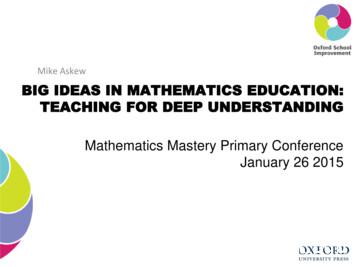Big Ideas In Primary Mathematics
Mike AskewBIG IDEAS IN MATHEMATICS EDUCATION:TEACHING FOR DEEP UNDERSTANDINGMathematics Mastery Primary ConferenceJanuary 26 20151
Fluency
FluencyProblemsolving
FluencyReasoningProblemsolving
FluencyReasoningMathsProblemsolving
Maths is nota spectatorsport.
Jot down
Inquiries Can you find all the multiples of 9?Given any 2-digit number can you predictwhich multiple of 9 it will produce? Why do you get a multiple of 9? What happens with three-digit numbers?
Objects of learningIndirect Fluency Problem solving Reasoning (Big Ideas)PROFICIENCIESDirect Fractions Multiplication 3-D shapesCONTENT10
As teachers we need tohave Big Ideas in mind inselecting tasks and whenteaching.
What is aBig Idea?
Big Ideas are Mathematically big Conceptually big Pedagogically big13
The Big Five Position on the number lineEquivalenceArithmetical reasoningClassificationMeanings and symbols14
The Big Five Position on the number line Equivalence Arithmetical reasoning Classification Meanings and symbolsPlus Pattern Place value Estimation15
Position onthe numberline
The numbers in primarymaths have a uniqueposition on the numberline.
Position on the numberline Putting numbers on a line links discrete andcontinuous quantities. Positioning numbers on the number line helpsdevelop understanding of the number system. The number line helps learners connectdifferent representations of numbers. Placing numbers at equal spaces on a numberline is a key skill and marker of understanding.18
Rational numbersIntegersPositive and negativeFractionsNumber lineWhole numbersNumberTrack19
National CurriculumMathematics is an interconnected subject inwhich pupils need to be able to move fluentlybetween representations of mathematical ideas.
National CurriculumY2Pupils identify, represent and estimate numbers usingdifferent representations, including the number lineThey check their calculations, including by adding tocheck subtraction and adding numbers in a differentorder to check addition. This establishescommutativity and associativity of additionThey use commutativity and inverse relations todevelop multiplicative reasoning (for example, 4 5 20 and 20 5 4).Pupils should count in fractions up to 10, starting fromany number and using the ½ and 2/4 equivalence onthe number line
Big Ideas are NOT age, levelor content dependent.
PIAGET
PIAGET
Working with Big Ideas is away of dealing withclassroom diversity andpromoting inclusiveclassrooms.
Equivalence
There are infinitely manyways to representnumbers, measures andnumber sentences.
Jot down
Reasoning chains10 x 82x812 x 86 x 1618
StructureFreedom
Experienced teachers do twoapparently contradictory things:They use more structures, and yetthey improvise more. Thechallenge facing every teacherand every school is to find thebalance of creativity and structurethat will optimise student learning.Sawyer
Variety or Variation?Variety‘Pick and mix’Most practice exercises contain varietyVariationCareful choice of WHAT to varyCareful choice what the variation will drawattention to
Reasoning chainsSTRUCTUREVariation builds and connectsOnly revealed one at a timeFREEDOMPupil choice of methodTeacher real time adjustments
Equivalence Representations that look different can all belinked to the same underlying mathematicalidea. Numbers and measures can be expressed inan infinite number of ways. Different representations highlight differentaspects of the mathematics. Calculating is often made easier by setting upan equivalent calculation.37
Reasoning (Big Ideas) Direct Fractions Multiplication 3-D shapes 10 CONTENT PROFICIENCIES . As teachers we need to have Big Ideas in mind in selecting tasks and when teaching. What is a Big Idea? Big Ideas are Mathematically big Conceptually big Pedagogically big 13 .
This book describes the big ideas of mathematics with respect to content, teaching and learning from levels or grades P to 12. This section looks at: (a) what big ideas are (their nature); (b) how they can assist learning; (c) how big ideas can be learnt; ( d) the different types of big ideas that are recognised by YuMi Deadly Mathematics
Ten Principles and Fourteen Big Ideas of Science Education Introduction: Why 'big ideas'? 1 Section One: Principles underpinning essential education in science 6 Section Two: Selecting big ideas in science 16 Section Three: From small to big ideas 24 Section Four: Working with big ideas in mind 42 Profiles of seminar participants 51
Now is the time to redefine your true self using Slader's BIG IDEAS MATH Integrated Mathematics I answers. Shed the societal and cultural narratives holding . Big Ideas Math Book 7th Grade Answer Key - CCSS Math . answers, big ideas math blue 4.6 puzzle time answers, big ideas math blue 4.2 puzzle time answers, 7.1 puzzle time answers big .
BIG Ideas to BIG Results provides the recipe for combining your big ideas with an inspired and engaged team. Simply put, it just works." —Larry Mondry, CEO, CSK Auto "BIG Ideas to BIG Results strikes a balance that is very difficult to achieve in that it's not so rigid as to seem artificial, yet not so flexible as to lack conviction.
5 Big Ideas Math: Modeling Real Life Grade 5 Student Edition Volume 2 9781635988949 Big Ideas Learning 2019 1st 10.53 5 Big Ideas Math: Modeling Real Life Grade 5 Student Edition Set 9781635989151 Big Ideas Learning 2019 1st 70.68 5 Big Ideas Math: Modeling Real Life Grade 5 Teaching Edition
Other ideas are termed 'umbrella big ideas' as they encompass or are embedded in a number of content areas and such ideas chosen were Pattern (n 7), Comparison (n 2), and Financial Literacy and Equivalence (n 1 each). It is worth noting that while the PSTs had been exposed to the article by Charles (2005) about 'big ideas' not
Primary Mathematics 3B (Marshall Cavendish Education, 2003) Primary Mathematics 4A (Marshall Cavendish Education, 2003) Primary Mathematics 5A (Marshall Cavendish Education, 2003) Primary Mathematics 5B (Marshall Cavendish Education, 2003) Primary Mathematics 6B (Marshall Cave
Thomas Coyne, LEM, Dir. Greg Lesko Nina Mascio Debbie Walters, LEM Faith Formation Lori Ellis, LEM, Religious Education Baptism/Marriage Please contact Lori Ellis at 412-462-8161 Confession Schedule Mondays at St. Therese at 7:00 p.m. Saturdays at Holy Trinity from 3:00-3:45 p.m. Saturdays at St. Max from 3:00-3:45 p.m. Hall Rentals Please call 412-461-1054 Website www.thomastheapostle.net .























